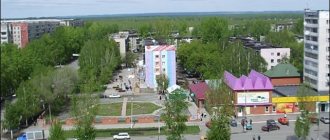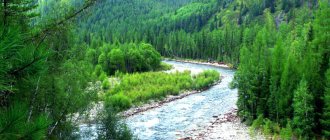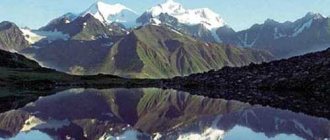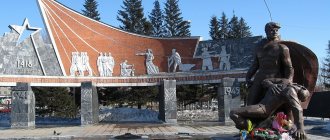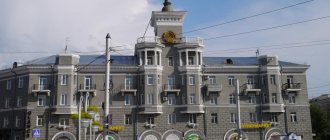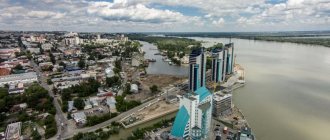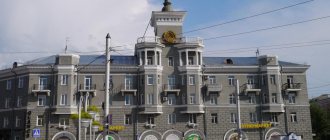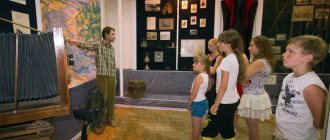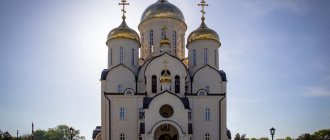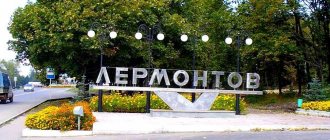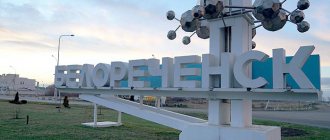List of settlements
Material Information
Belokurikha is a resort town of federal significance in the Altai Territory. The geographical coordinates of the resort are 52° north latitude and 85° east longitude. Altitude above sea level 225-250 meters. The resort is located 65 kilometers from the city of Biysk. You can get here by road from the city of Biysk, crossing two powerful rivers - Biya and Katun.
Tourist area: Belokurikha District
The official founding date is 1803 (which should be attributed to the village of Starobelokurikha). City status since 1982. Since 1992 it has the status of a resort of federal significance.
Treatment in Belokurikha
The southern part of the resort is occupied by fairly high mountains, covered with magnificent evergreen coniferous forests.
The landscape comes to life thanks to the mountain river Belokurikha with numerous streams. Upstream, the narrow valley turns into a mountain gorge, and to the north it turns into the plains of the Ob region. There are many wonderful, unforgettable places that will remain in your memory for a long time, and Belokurikha is undoubtedly one of them. The grandeur, the solemn beauty of Altai, the crystal clear air - everything here breathes health and a thirst for life. Gazebo at the resort
Mineral waters were first found in the area in the late 1700s when Russian settlers came to the land. The city's name means "White Smoke", symbolizing the fog rising from the springs. And in the middle of the 19th century, the healing properties of local water were discovered. Although the settlement was founded in 1803, the resort did not officially open until 1867, when a hospital was built. The local radon springs were widely known for healing skin, treating eye diseases and joint diseases.
Since 1920, the village began to turn into a full-fledged resort town. Sanatoriums, restaurants, solariums and hydrotherapy baths were built. Soviet officials were the most frequent guests here, and the famous Russian writer Konstantin Paustovsky even lived for some time.
Healing springs
Belokurikha belongs to the balneological resorts. The main healing factor of Belokurikha are radioactive springs, the water of which contains dissolved emanation of radium and its decay products. Emanation, or radon, is an intermediate gaseous product of the decay of radium and, in turn, is also an unstable element and decays into radium A, B, C, C', D, D' and others. The sequential decay of radioactive elements occurs as a result of the fact that a stream of positively charged particles - alpha rays or negatively charged particles - beta rays - is emitted from the atom.
In addition to alpha and beta rays, radioactive elements emit gamma rays, similar to X-rays. The decay time of different radioactive elements is different. So, for example, the transformation of radium into radon requires 1,580 years, radon into radium A - 3.85 days, radium A into radium B - 3.05 minutes.
The decay products of radium (radon) emanation are solid particles, which, like the emanation, are contained in radioactive water. Thus, the effect exerted by radioactive water on the body is very complex, because, along with the emanation of radium, a person using a radioactive source is influenced by the continuously emitted stream of alpha, beta and gamma rays and deposited on the skin in the form of " active plaque" solid radioactive substances.
From here it becomes clear why a strict dosage of therapeutic radioactive procedures is established for individual patients and why unauthorized use of radon sources is completely unacceptable. The amount of emanation in water is measured in conventional units of mache.
According to the definition adopted by the Scientific Medical Council of the People's Commissariat of Health of the RSFSR, all radioactive sources according to the content of radium emanation are divided into three groups: weakly radioactive, with an emanation content of 10-27 mach, moderately radioactive, with an emanation content of 28-82 mach, and highly radioactive, with a high content of emanation.
Studies of the radioactivity of Belokurikha sources have been carried out repeatedly since 1907. Detailed studies were carried out by parties of the West Siberian Geological Trust and the Central Scientific Geological Prospecting Institute. Systematic scientific observations and studies of sources have been carried out in recent years by Associate Professor Saratovkin. The radioactivity of the water in individual wells at Belokurikha ranges from 16 to 33 mach, the radioactivity of gases from Belokurikha springs ranges from 83 to 168 mach (According to the Radiometric Unit of the West Siberian Geological Exploration Trust).
According to Saratovkin, the radioactivity of gases is somewhat lower and amounts to 60-64 mach per liter of water.
According to long-term observations, the radioactivity of water is constant, although in certain periods of the year and even during the day it may show slight deviations. The waters of the Belokurikha springs should be considered moderately radioactive.
The water of the Belokurikha springs when reaching the surface has a high temperature, which remains constant. This temperature varies for individual wells from 27 to 36.0° C. The temperature of well No. 15, the water of which is mainly used, is usually 35-35.8°, which allows the use of therapeutic baths for most patients without heating.
This temperature of the water of the 15th well is an extremely valuable factor, since during heating and mechanical mixing, as observations show, part of the emanation, especially contained in gases, is lost.
The presence of sources with a lower temperature makes it possible to vary the bath temperature for different patients depending on the indications. In some cases, for weakened patients who need warmer baths, or who cannot tolerate natural temperature well, baths are given, as prescribed by a doctor, heated to the required temperature.
The water flow of Belokurikha radioactive springs is high. Only one 15th well can produce up to 200 liters per minute.
Drilling to a depth of 200 meters showed that the water flow increases, but its radioactivity drops to 12 mahe. Geological exploration has established that the most favorable for exploitation is the aquifer at a depth of 78 meters - at a temperature of 36° its radioactivity is equal to 35 mach.
Due to its balneological properties, Belokurikha should be distinguished in comparison with other radioactive resorts.
The most famous radioactive resorts are Tskaltubo in Georgia, Denety-Oguz in the foothills of the Tien Shan, Pyatigorsk in the Caucasus, Molokovka and Yamkun in Transbaikalia, Kissegach in the Urals, Kunasiri, Kholmsk, Providence on the Kuril Islands, etc. Many of these sources have a higher radioactivity - Molokovka 200 mache, Yamkun - 218 mache, but their disadvantage is the low water temperature.
The Pyatigorsk springs, similar in radioactivity to the Belokurikha springs, have a temperature of 16-20° and an insufficient flow rate; Tskaltubo springs have low radioactivity.
As numerous studies show, the emanation of radium and its decay products have both a local reflex effect through nerve endings embedded in the skin and mucous membranes, through contact with the latter (baths, drinking radioactive water, the use of irrigation, the action of a stream of air saturated with emanation), and general - by entering the blood through the skin and mucous membranes or through the lungs, inhaling air containing emanation.
At the resort, the following methods of using radioactive water are used for medicinal purposes.
Radioactive baths. When taking a radioactive bath, the nerve endings in the skin are affected, on the one hand, by a stream of continuously emitted alpha, beta and gamma rays, of which gamma rays have the greatest penetrating power. They act in a locally irritating manner and, penetrating through the skin, enter the blood, producing a general effect.
The solid radioactive products present in the bath, formed as a result of the decay of radium emanation, are deposited on the skin in the form of so-called. "active raid". It also affects the patient, and this effect continues for some time after leaving the bath. Drying the body with a towel after a bath does not affect the amount of active plaque remaining. As studies show, if a patient makes movements in the bath, the amount of “active plaque” on the skin increases.
The emanation continuously evaporates from the bath and enters the surrounding air. A patient taking a bath inhales an emanation along with the air, which enters the lungs and from there into the blood. Inhalation of emanated air is the second source of saturation of the body with radon.
Thus, a patient taking a bath is exposed to a double effect of radium emanation - through the skin and by inhalation, through the lungs. When the bath is heated, the amount of radium emanation contained in the air increases noticeably.
At the Belokurikha resort, in addition to baths, swimming in the pool is used. The effect of the pool is stronger both in the amount of “active plaque” deposited and in the amount of inhaled emanation.
Drinking water. When water is taken orally, radium emanation enters the gastrointestinal tract along with water, which acts on nerve endings, and is also absorbed through the intestinal mucosa into the circulatory system of the portal vein (which collects blood from organs associated with digestion) and is released through the lungs. The effect of radioactive water when taken orally is mainly local, on the digestive organs. The general action, through the arterial system, is much less. Drinking radioactive water is recommended mainly for inflammatory diseases of the gastrointestinal tract.
Emanatorium. It is generally accepted that the most intensive entry of radium emanation into the blood occurs through inhalation of radon contained in the air. After 15-30 minutes of inhalation of emanated air, the amount of emanation in a liter of blood corresponds to the content of emanation in a liter of inhaled air. To obtain air saturated with emanation at the Belokurikha resort, Associate Professor Saratovkin, at the suggestion of prof. G. M. Shershevsky, designed a deemanator that ensures air saturation up to 20 mach in one liter of water.
Radioactive applicators. For the treatment of a number of diseases, including skin and thyroid diseases, those proposed by prof. Shershevsky so-called radioactive applicators.
Applicators are bags, most often made of waffle fabric, with double walls, through which radioactive water is passed for a long time. When water flows, solid products of radioactive decay are retained on the walls of the bag. Compresses saturated with radioactive products are applied topically and act with gamma radiation. Treatment with applicators is usually combined with general radioactive baths.
Along with specific treatment with radon water, combined treatment using physiotherapy, massage, helio- and aerotherapy, etc. is widely used in Belokurikha.
***
The medicinal value of the Belokurikha resort is undeniable. The best proof of this is the many thousands of patients who recovered or improved their health after treatment with Belokurikha radioactive waters.
However, as long-term observations show, a positive effect from treatment is obtained only in cases where doctors adhere to the correct indications when sending them to a resort.
Patients sent to a resort without indications, and even more so with contraindications, not only do not get a good result from treatment, but can also experience a significant deterioration in their health. In particular, it has been noted that the use of radioactive procedures often causes an exacerbation of the tuberculosis process even in a quiescent stage.
Therefore, those wishing to go to Belokurikha should consult a doctor and purchase a ticket only if there is a positive conclusion from the resort selection committee.
The material was prepared by E. Gavrilov on January 11, 2015. A link to the site is required!
Hotels
There are many sanatoriums in Belokurikha that are open all year round. The most famous are “Katun”, “Belokurikha”, “Siberia”. As a rule, it is very difficult to get a place in them; all vouchers and courses are sold out long before the ski season.
Room at the Belovodye Hotel
You can stay in boarding houses, which are almost in no way inferior to sanatoriums in terms of comfort, as well as in prices - for example, during the New Year holidays, accommodation in a boarding house or hotel can cost up to 7 thousand rubles per day. You can stay in guest houses on a budget - here they will ask for 1500-2000 rubles per room.
Visitors' opinions about the resort
The majority of guests who have visited Belokurikha remain satisfied with the services provided by the resort. Among those who visited this place are famous personalities of the country: actors, presenters, athletes, ministers of culture and health, each of whom highly appreciates the level of recreation and treatment here.
Spending time in this area is gaining popularity among foreign tourists. German, French and Japanese scientists recognized the resort as unique, which led to an increase in the flow of visitors from abroad. The summer months and New Year's time in Belokurikha continue to be the most attractive for visitors.
© Galina Eremina
Trails
On the slopes of Mount Tserkovka there is the Blagodat ski complex. There are only 6 trails with a total length of about 7 km and a height difference of up to 550 m. At the same time, both amateurs and beginners, as well as professional skiers, will find their slopes here.
The most difficult are the red slopes from the Tserkovka chairlift and the Blagodat ski lift (under renovation). “Tserkovka” starts from the top of the mountain; it is the longest route of the resort (2.5 km). And the easiest, “greenest” route is the Altai-West route. This is a gentle slope with a height difference of only 150 m, which is excellent for beginner skiers and children, equipped with additional lighting for evening skiing. The most popular slope among tourists is “Grace,” which is 1,300 meters long and has a slight elevation difference.
Skiers like the wide blue Katun piste, which starts from two Katun rope tows running parallel to each other. This is the main slope of Belokurikha, 850 m long, equipped with additional lighting and an artificial snowmaking system. Despite the small difference in height (about 170 m), skiing on it requires some skill.
Trails in Belokurikha
On the other side of Altai there is the Severny descent, which is narrower and more difficult. Unlike other slopes, there is always a lot of snow here, which promotes skiing not only on the piste, but also freeride.
In addition to the Blagodat ski resort, not far from Belokurikha there are two more ski resorts and Yakovka.
In Danilovka, which is located just 4 km from Belokurikha, there is only one track 1 km long with a height difference of 150 m. It is perfect for beginners. The slope is equipped with a drag lift.
“Yakovka” is located on the slope of the mountain of the same name. The elevation difference is about 300 m. Natural snow cover lasts the longest here, so you can ski until mid-spring. There is a drag lift at Yakovka.
Climate of the area
The weather in Belokurikha is considered quite mild for Siberia. There is a complete absence of unbearable heat, wind and severe Siberian frosts, and the atmospheric pressure is stable and does not have significant changes. Even in the cold season, at a temperature of -30 degrees, the frost does not seem as severe as in neighboring cities. The frequency of sunny days a year here is approximately the same as in the resorts of the Krasnodar Territory, and the latter loses in this matter to Belokurikha. All these points make the holiday of visitors as comfortable as possible and relieve the adaptation process for both older people and children.
Spring in the city is warm and comes relatively early. In summer, the main part of the territory experiences cool, mostly clear weather. The air temperature in the summer months is +18 - +20 °C, the atmospheric pressure is lower than in spring and winter. In autumn, the weather continues to remain comfortable, with little precipitation falling. The formation of snow cover occurs in November. Holidays here are good at any time of the year: in Belokurikha you can raft down mountain rivers and climb to the peaks, go hiking and improve your health on health walks along terrain courses - paths specially designed for this. At the resort you have the opportunity to take part in extreme rafting, go horseback riding, snowboarding or cycling.
© Olga TESEIKO
Ski passes
A one-time climb up the mountain on a rope rope will cost 70 rubles on weekdays and 100 rubles on holidays.
At the Blagodat ski resort, a ski pass for rope tows for 1 hour costs 150 rubles on weekdays and 200 on holidays, for an hour and a half - 250 on weekdays and 350 on holidays. There are also ski passes for 80, 200 and 300 minutes. An unlimited subscription for the whole day on weekdays will cost 1000 rubles, on holidays - 1200 rubles. Also, for any card of any ski pass you will have to pay 100 rubles.
The ascent to Tserkovka (chair lift) for skiers and snowboarders will cost 200 rubles. For tourists without skis, such a trip will cost 400 rubles. The cable car is open until 17:00.
Things to do
For thrill-seekers, the resort has an extreme park with several snowboard trails with freestyle and slopestyle jumps. In the sanatoriums “Katun”, “Sibir”, “Belokurikha”, “Altai-West” there are ski equipment rental points. There is a school of instructors. You can also go tubing down the slopes or ride a snowmobile.
To relax after skiing in the cold air, Belokurikha sanatoriums and hotels offer a wide range of SPA treatments using local healing water and healing mud.
Water park at the Belovodye hotel
In Belokurikha, at the Belovodye Hotel, there is a water park with two swimming pools, water slides and attractions. You can go to the Aurora Zoo with children.
If you prefer active recreation even after a day on the slopes, the resort opens wide the doors of its nightclubs, bowling centers, numerous cafes and restaurants, billiard rooms and other entertainment venues.
Attractions
You can see the beauty of Altai by booking an excursion by helicopter, paraglider or even hot air balloon. On Mount Tserkovka, the top of which can be reached by cable car, there is a natural park. The main attraction is the rocks and rock formations, for example, the “Master of the Mountain” rock is well known. It is believed that the good spirit of Altai lives in the rock, which can make wishes come true. Tourists will encounter many more such rock formations along the way - for example, “Stone Flower” or “Woman’s Joy” - guess for yourself what they look like.
Rocks in Belokurikha
Tourists, and locals too, often go for water to the Dunyashkin Klyuch spring, which is located next to the lower station of the cable car to Mount Tserkovka. Thanks to its unique microclimate, pristine nature and mineral springs with natural healing properties, this wonderful place attracts more and more tourists every year and is considered one of the best resorts not only in Siberia, but also in Russia as a whole.

